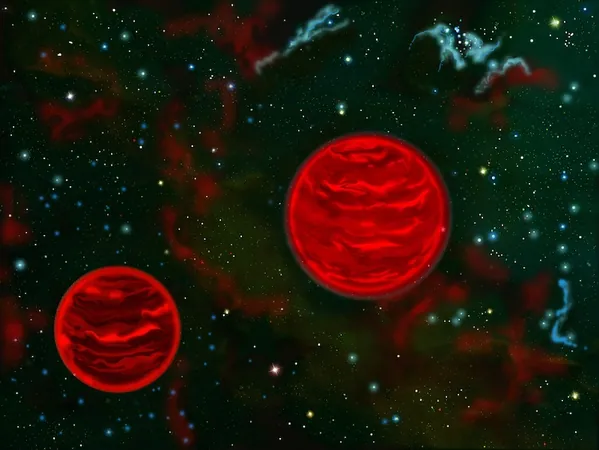
The Shocking Truth Behind Rogue Planets: Did Hot Stars Erode Them?
2024-11-08
Author: Yu
Introduction
The universe is a vast and mysterious place, and one of its most puzzling phenomena is the existence of rogue planets. These intriguing celestial bodies float through space, untethered to any star. A recent study has provided a compelling explanation for their formation: they might be remnants of binary star systems eroded away by the intense heat of neighboring stars!
Differentiating Stars and Planets
To understand rogue planets, we need to first differentiate between stars and planets. Stars possess enough mass to undergo nuclear fusion, turning hydrogen into helium and generating their own light. In contrast, planets lack this mass and, thus, cannot create energy in the same way. However, there are exceptions, such as brown dwarfs, which are too massive to be considered planets yet not quite massive enough to qualify as stars. These intriguing objects can fuse deuterium but fail to produce significant helium.
Emergence of Rogue Planets
So, what causes the emergence of rogue planets? Traditional models suggest stars form through the gravitational collapse of gas and dust in molecular clouds, allowing them to amass mass rapidly. However, rogue planets appear to defy this model, with observations indicating that they often possess considerable mass, sometimes exceeding that of traditional planets like Jupiter.
Recent Discoveries and Findings
A recent discovery by the James Webb Space Telescope (JWST) examined the Orion Nebula and uncovered 540 free-floating Jupiter-mass objects, including an astonishing 42 that fit the category of Jupiter-mass binary objects (JuMBOs). Surpassing their expected rarity, these JuMBOs represent nearly 8% of the rogue planets identified in the nebula. This startling statistic hints at a fundamental shift in our understanding of planet formation.
Orbital Separation and Implications
The clue to their origin may be found in the orbital separation of these JuMBOs, which typically range from 28 to 384 Astronomical Units (AU). This distance is strikingly similar to binary stars, which, when formed around the mass of our Sun, frequently exist within a range of 50 to 300 AU. Binary stars are abundant in stellar nurseries like the Orion Nebula, where conditions can be perilous.
Impact of Massive Stars
Massive stars forming within these regions emit intense ionizing radiation that can literally blast away the material from nearby celestial bodies. Thus, the rogue planets we observe may actually be the remnants of binary stars that lost substantial mass due to the extreme conditions in stellar nurseries. Rather than merely being binary planets, they represent the failed remnants of once-promising binary stars.
Survival Against the Odds
This phenomenon could also shed light on why so many rogue planets have masses greater than Jupiter. The intense energy from nearby hot stars not only strips these objects of their mass but also propels them out of their original star systems entirely. What seems like an empty existence in the cosmos may actually be a tale of survival against the odds.
Conclusion
The study of rogue planets is changing rapidly, and as we venture further into the universe’s mysteries, our understanding of these enigmatic bodies will undoubtedly continue to evolve. So next time you look up at the stars, don't just think about the ones you see; consider the rogue planets wandering through the void, like cosmic ghosts haunted by the remnants of their stellar origins!


 Brasil (PT)
Brasil (PT)
 Canada (EN)
Canada (EN)
 Chile (ES)
Chile (ES)
 España (ES)
España (ES)
 France (FR)
France (FR)
 Hong Kong (EN)
Hong Kong (EN)
 Italia (IT)
Italia (IT)
 日本 (JA)
日本 (JA)
 Magyarország (HU)
Magyarország (HU)
 Norge (NO)
Norge (NO)
 Polska (PL)
Polska (PL)
 Schweiz (DE)
Schweiz (DE)
 Singapore (EN)
Singapore (EN)
 Sverige (SV)
Sverige (SV)
 Suomi (FI)
Suomi (FI)
 Türkiye (TR)
Türkiye (TR)